Multi-Scenario Simulation of Future Land Use in the Beijiang River Basin Under Multidimensional Ecological Constraints
Abstract
1. Introduction
2. Materials and Methods
2.1. Research Area
2.2. Data Sources
2.3. Research Methodology
2.3.1. Spatiotemporal Pattern Analysis of Land Use/Cover Change
2.3.2. Construction of Ecological Constraints (ES)
- Habitat Quality
- 2.
- Water Source Conservation
- 3.
- Storage of Carbon
- 4.
- Soil Retention
2.3.3. Establishment of ES-PLUS Model Based on Ecological Constraints
2.3.4. Multi-Scenario Simulation of Future Land Use Based on ES-PLUS Model
3. Results
3.1. Spatiotemporal Analysis of Land Cover Change in the Beijiang River Basin from 1980 to 2020
3.1.1. Spatiotemporal Distribution Characteristics of Land Use
3.1.2. Dynamic Analysis of Land Use
3.1.3. Analysis of Land Use Transition
3.2. Analysis of Ecological Constraint Construction Results
3.2.1. Spatial Patterns of Ecosystem Services and Ecological Sources
3.2.2. Construction of Ecological Constraints Under Three Cumulative Resistance Thresholds
3.3. Land Use Analysis of the Beijiang River Basin Under Multiple Scenarios
3.3.1. Model Accuracy Verification
3.3.2. Examination of the Outcomes of the Multi-Scenario Land Use Simulation in the Beijiang River Basin for the Year 2050
- (1)
- Natural Development Scenario (NDS)
- (2)
- Economic Development Scenario (EDS)
- (3)
- Ecological Protection Scenario (EPS)
- (4)
- Comprehensive Development Scenario (CDS)
4. Discussion
4.1. Evaluation of Multi-Scenario Simulation Results of Land Use in the Beijiang River Basin and Its Ecological Significance
4.2. Key Policy Implications for Sustainable Land Use and Ecological Protection in the Beijiang River Basin
4.3. Innovation and Future Research Directions of Land Use Simulation
5. Conclusions
- (1)
- Over the past 40 years, 95% of the land use in the Beijiang River Basin comprised forests, cultivated land, and grassland. While cultivated land and grassland have continuously decreased, water bodies and construction land have increased. Unused land exhibited the highest single dynamic degree of change, reaching 5.67%.
- (2)
- By applying circuit theory and setting multidimensional ecological constraints based on four ecosystem services (habitat quality, water conservation, carbon storage, and soil retention) to drive the ES-PLUS model for simulating future land use changes, the results showed a Kappa coefficient of 0.93 and an overall accuracy of 0.96. By 2050, the simulation results indicated significant differences in change trends across the four development scenarios. Notably, the growth rate of construction land under the Comprehensive Development Scenario was significantly lower than that observed under the Economic Development Scenario, which could protect ecological areas such as water bodies and forests, mitigating the encroachment and impact of human activities and economic development on critical ecological resources.
- (3)
- The model effectively alleviated the negative ecological impacts caused by regional economic development and slowed the disorderly expansion of urban areas into ecological land. It promoted the coordination of economic development and ecological protection goals in the basin, providing a solid scientific foundation for formulating sustainable land management strategies in the future.
Author Contributions
Funding
Institutional Review Board Statement
Informed Consent Statement
Data Availability Statement
Acknowledgments
Conflicts of Interest
References
- Gao, J.; Zou, C.; Zhang, K.; Xu, M.; Wang, Y. The establishment of Chinese ecological conservation redline and insights into improving international protected areas. J. Environ. Manag. 2020, 264, 110505. [Google Scholar] [CrossRef] [PubMed]
- Wang, C.; Yu, C.; Chen, T.; Feng, Z.; Hu, Y.; Wu, K. Can the establishment of ecological security patterns improve ecological protection? An example of Nanchang, China. Sci. Total Environ. 2020, 740, 140051. [Google Scholar] [CrossRef] [PubMed]
- del Carmen Sabatini, M.; Verdiell, A.; Iglesias, R.M.R.; Vidal, M. A quantitative method for zoning of protected areas and its spatial ecological implications. J. Environ. Manag. 2007, 83, 198–206. [Google Scholar] [CrossRef] [PubMed]
- Hu, S.; Chen, L.; Li, L.; Zhang, T.; Yuan, L.; Cheng, L.; Wang, J.; Wen, M. Simulation of land use change and ecosystem service value dynamics under ecological constraints in Anhui Province, China. Int. J. Environ. Res. Public Health 2020, 17, 4228. [Google Scholar] [CrossRef] [PubMed]
- Nie, W.; Xu, B.; Ma, S.; Yang, F.; Shi, Y.; Liu, B.; Hao, N.; Wu, R.; Lin, W.; Bao, Z. Coupling an Ecological Network with Multi-Scenario Land Use Simulation: An Ecological Spatial Constraint Approach. Remote Sens. 2022, 14, 6099. [Google Scholar] [CrossRef]
- Samways, M.J.; Bazelet, C.S.; Pryke, J.S. Provision of ecosystem services by large scale corridors and ecological networks. Biodivers. Conserv. 2010, 19, 2949–2962. [Google Scholar] [CrossRef]
- Liu, H.; Wang, Z.; Zhang, L.; Tang, F.; Wang, G.; Li, M. Construction of an ecological security network in the Fenhe River Basin and its temporal and spatial evolution characteristics. J. Clean. Prod. 2023, 417, 137961. [Google Scholar] [CrossRef]
- Xu, X.; Wang, S.; Yan, G.; He, X. Ecological Security Assessment Based on the “Importance–Sensitivity–Connectivity” Index and Pattern Construction: A Case Study of Xiliu Ditch in the Yellow River Basin, China. Land 2023, 12, 1296. [Google Scholar] [CrossRef]
- Wang, Y.; Long, Z.; Song, Y. Study on the construction of the ecological security pattern of the lancang river basin (Yunnan section) based on inVEST-MSPA-circuit theory. Sustainability 2022, 15, 477. [Google Scholar] [CrossRef]
- Wang, X.; Xie, X.; Wang, Z.; Lin, H.; Liu, Y.; Xie, H.; Liu, X. Construction and Optimization of an Ecological Security Pattern Based on the MCR Model: A Case Study of the Minjiang River Basin in Eastern China. Int. J. Environ. Res. Public Health 2022, 19, 8370. [Google Scholar] [CrossRef]
- Zhou, S.; Song, Y.; Li, Y.; Wang, J.; Zhang, L. Construction of ecological security pattern for plateau lake based on MSPA–MCR model: A case study of Dianchi lake area. Sustainability 2022, 14, 14532. [Google Scholar] [CrossRef]
- Chen, W.; Huimin, L.; Wang, X. Construction and optimization of regional ecological security patterns based on MSPA-MCR-GA Model: A case study of Dongting Lake Basin in China. Ecol. Indic. 2024, 165, 112169. [Google Scholar] [CrossRef]
- Pan, X.; Yimin, W.; Zhang, Z. Identification and Optimization of Ecological Network in Arid Inland River Basin Using MSPA and Spatial Syntax: A Case Study of Shule River Basin, NW China. Land 2023, 12, 292. [Google Scholar] [CrossRef]
- Yang, L.; Suo, M.; Gao, S.; Jiao, H. Construction of an ecological network based on an integrated approach and circuit theory: A case study of Panzhou in Guizhou Province. Sustainability 2022, 14, 9136. [Google Scholar] [CrossRef]
- Peng, J.; Yang, Y.; Liu, Y.; Du, Y.; Meersmans, J.; Qiu, S. Linking ecosystem services and circuit theory to identify ecological security patterns. Sci. Total Environ. 2018, 644, 781–790. [Google Scholar] [CrossRef]
- Li, J.; Xu, J.; Chu, X. The construction of a regional ecological security pattern based on circuit theory. Sustainability 2019, 11, 6343. [Google Scholar] [CrossRef]
- Xu, J.; Fan, F.; Liu, Y.; Dong, J.; Chen, J. Construction of ecological security patterns in nature reserves based on ecosystem services and circuit theory: A case study in Wenchuan, China. Int. J. Environ. Res. Public Health 2019, 16, 3220. [Google Scholar] [CrossRef] [PubMed]
- Li, L.; Huang, X.; Wu, D.; Yang, H. Construction of ecological security pattern adapting to future land use change in Pearl River Delta, China. Appl. Geogr. 2023, 154, 102946. [Google Scholar] [CrossRef]
- Ferretti, V.; Pomarico, S. An integrated approach for studying the land suitability for ecological corridors through spatial multicriteria evaluations. Environ. Dev. Sustain. 2013, 15, 859–885. [Google Scholar] [CrossRef]
- Prokopová, M.; Salvati, L.; Egidi, G.; Cudlín, O.; Včeláková, R.; Plch, R.; Cudlín, P. Envisioning present and future land-use change under varying ecological regimes and their influence on landscape stability. Sustainability 2019, 11, 4654. [Google Scholar] [CrossRef]
- Wang, H.-H.; LI, H.-T.; Xie, M.-M.; Xu, M.; Li, S.-L.; Bai, Z.-K. Construction of ecological security pattern for systematic restoration of industrial and mining land in resource-based cities. J. Nat. Resour. 2020, 35, 162–173. [Google Scholar]
- He, X.; Yuan, Q.; Zeng, Y.; Li, G. Construction and Evaluation of an Ecological Network for Dongguan City Based on Urban Big Data POIs and Circuit Theory. Bull. Soil Water Conserv. 2023, 43, 237–247. [Google Scholar] [CrossRef]
- Zhao, Z.; Fang, H.; Yuan, Q.; Wu, Y. Research on the construction of ecological corridor habitat network in Songhua River. J. Nanjing For. Univ. (Nat. Sci. Ed.) 2024, 48, 261–270. [Google Scholar] [CrossRef]
- Zhou, L.; Dang, X.; Sun, Q.; Wang, S. Multi-scenario simulation of urban land change in Shanghai by random forest and CA-Markov model. Sustain. Cities Soc. 2020, 55, 102045. [Google Scholar] [CrossRef]
- Li, F.; Wang, L.; Chen, Z.; Clarke, K.C.; Li, M.; Jiang, P. Extending the SLEUTH model to integrate habitat quality into urban growth simulation. J. Environ. Manag. 2018, 217, 486–498. [Google Scholar] [CrossRef]
- Wang, Z.; Li, X.; Mao, Y.; Li, L.; Wang, X.; Lin, Q. Dynamic simulation of land use change and assessment of carbon storage based on climate change scenarios at the city level: A case study of Bortala, China. Ecol. Indic. 2022, 134, 108499. [Google Scholar] [CrossRef]
- Zhang, S.; Yang, P.; Xia, J.; Wang, W.; Cai, W.; Chen, N.; Hu, S.; Luo, X.; Li, J.; Zhan, C. Land use/land cover prediction and analysis of the middle reaches of the Yangtze River under different scenarios. Sci. Total Environ. 2022, 833, 155238. [Google Scholar] [CrossRef] [PubMed]
- Lu, C.; Qi, X.; Zheng, Z.; Jia, K. PLUS-model based multi-scenario land space simulation of the Lower Yellow River Region and its ecological effects. Sustainability 2022, 14, 6942. [Google Scholar] [CrossRef]
- Lin, X.; Fu, H. Multi-scenario simulation analysis of cultivated land based on PLUS model—A case study of Haikou, China. Front. Ecol. Evol. 2023, 11, 1197419. [Google Scholar] [CrossRef]
- Hao, W.; Cao, Z.; Ou, S.; Qin, Y.; Wang, Z.; Yang, S.; Tiando, D.S.; Fan, X. A Simulation Analysis of Land Use Changes in the Yarlung Zangbo River and Its Two Tributaries of Tibet Using the Markov–PLUS Model. Sustainability 2023, 15, 1376. [Google Scholar] [CrossRef]
- Mo, J.; Sun, P.; Shen, D.; Li, N.; Zhang, J.; Wang, K. Simulation Analysis of Land-Use Spatial Conflict in a Geopark Based on the GMOP–Markov–PLUS Model: A Case Study of Yimengshan Geopark, China. Land 2023, 12, 1291. [Google Scholar] [CrossRef]
- Liu, X.; Liu, Y.; Wang, Y.; Liu, Z. Evaluating potential impacts of land use changes on water supply–demand under multiple development scenarios in dryland region. J. Hydrol. 2022, 610, 127811. [Google Scholar] [CrossRef]
- Sohl, T.L.; Sleeter, B.M.; Zhu, Z.; Sayler, K.L.; Bennett, S.; Bouchard, M.; Reker, R.; Hawbaker, T.; Wein, A. A land-use and land-cover modeling strategy to support a national assessment of carbon stocks and fluxes. Appl. Geogr. 2012, 34, 111–124. [Google Scholar] [CrossRef]
- Zhang, Y.; Naerkezi, N.; Zhang, Y.; Wang, B. Multi-Scenario Land Use/Cover Change and Its Impact on Carbon Storage Based on the Coupled GMOP-PLUS-InVEST Model in the Hexi Corridor, China. Sustainability 2024, 16, 1402. [Google Scholar] [CrossRef]
- Yin, J.; He, F.; Xiong, Y.J.; Qiu, G.Y. Effects of land use/land cover and climate changes on surface runoff in a semi-humid and semi-arid transition zone in northwest China. Hydrol. Earth Syst. Sci. 2017, 21, 183–196. [Google Scholar] [CrossRef]
- Xu, A.; Hu, M.; Shi, J.; Meng, X.; Bai, Q.; Guo, J.; Zhang, S. Temporal and spatial changes of carbon storage in the Shiyang River Basin ecosystem and multi-scenario simulation. China Environ. Sci. 2024, 6, 3365–3375. [Google Scholar] [CrossRef]
- Yang, Z.; Niu, J.; Fan, D.; Zhang, Z.; Du, Z.; Zhao, C. Response and prediction of runoff to land use changes in the Kuye River Basin based on SWAT and PLUS models. J. Soil Water Conserv. 2024, 38, 289–299. [Google Scholar]
- Jiang, X.; Duan, H.; Liao, J.; Song, X.; Xue, X. Land use study in the midstream of the Heihe River Basin based on the PLUS-SD coupled model. Arid. Zone Res. 2022, 39, 1246–1258. [Google Scholar]
- Chen, S.; Huang, B.; Shi, F.; Qiu, J.; She, D. Spatiotemporal Changes and Probabilistic Statistical Characteristics of Extreme Precipitation in the Beijiang River Basin from 1956 to 2016. China Rural. Water Hydropower 2019, 10, 47–53. [Google Scholar]
- Li, H.; Zhang, Q.; Gu, X.; Sun, P.; Kong, D. Spatiotemporal Characteristics and Influencing Factors of Flood Magnitude, Frequency, and Peak Occurrence Time in the Beijiang River Basin. J. Wuhan Univ. 2016, 62, 389–400. [Google Scholar] [CrossRef]
- Zhao, Z.; Chen, S.; Yu, G.; Li, D.; Jia, K.; Zhao, C.; Li, J.; Qin, B. Remote Sensing Method for Forest Deforestation in the Beijiang River Basin Based on Recent Intensive Satellite Data. Trop. Geogr. 2024, 44, 2091–2103. [Google Scholar] [CrossRef]
- Deng, J.; Yu, F.; Sun, D.; Deng, Z.; Kang, J.; Ding, X. Study on the Spatial Distribution Characteristics of Soil Phosphorus in the Beijiang River Basin. For. Environ. Sci. 2022, 38, 60–64. [Google Scholar]
- Li, J.; Luo, X.; Zhu, S.; Zhang, W.; Xu, Z.; Huo, Z.; Tian, Z.; Huo, G. Study on the Impact of Land Use/Cover Change on Hydrological Processes in the Beijiang River Basin. Yangtze River 2020, 51, 89–94. [Google Scholar] [CrossRef]
- Li, M. Hydrological Response Simulation of Land Cover and Meteorological Conditions Changes in the Beijiang River Basin Based on SWAT. Master’s Thesis, Graduate School of Chinese Academy of Sciences (Guangzhou Institute of Geochemistry), Guangzhou, China, 2015. [Google Scholar]
- Li, Y. Multi-Scenario Simulation of Land Use in Fengxin County Under the Constraint of Ecological Risk. Master’s Thesis, Jiangxi Agricultural University, Nanchang, China, 2022. [Google Scholar] [CrossRef]
- Wang, F.; Li, J.; Wang, J.; Xiang, S.; Chen, X.; Yi, X.; Huang, T. Multi-scenario simulation of land use change in the Chengdu-Chongqing Economic Zone and its impact on carbon storage. Environ. Sci. 2024, 1–17. [Google Scholar] [CrossRef]
- Yang, J.; Wang, Z.; Yang, J.; Li, F.; Li, D. Land Use and Ecological Risk Analysis in Wanzhou District, Chongqing from 1992 to 2022. J. Northwest For. Univ. 2024, 39, 241–251+262. [Google Scholar]
- Li, G.; Li, H.; Wang, L.; Jiang, F.; Feng, Z. Analysis of Land Use Change and Its Socio-Economic Driving Factors in Qinghai Province. Grassl. Sci. 2022, 39, 2604–2616. [Google Scholar]
- Qian, Y.; Dong, Z.; Yan, Y.; Tang, L. Ecological risk assessment models for simulating impacts of land use and landscape pattern on ecosystem services. Sci. Total Environ. 2022, 833, 155218. [Google Scholar] [CrossRef] [PubMed]
- Hu, W.; Li, G.; Gao, Z.; Jia, G.; Wang, Z.; Li, Y. Assessment of the impact of the Poplar Ecological Retreat Project on water conservation in the Dongting Lake wetland region using the InVEST model. Sci. Total Environ. 2020, 733, 139423. [Google Scholar] [CrossRef] [PubMed]
- Hou, Y.; Li, B.; Müller, F.; Chen, W. Ecosystem services of human-dominated watersheds and land use influences: A case study from the Dianchi Lake watershed in China. Environ. Monit. Assess. 2016, 188, 1–19. [Google Scholar] [CrossRef] [PubMed]
- Zhang, F.; Chen, Y.; Wang, W.; Jim, C.Y.; Zhang, Z.; Tan, M.L.; Liu, C.; Chan, N.W.; Wang, D.; Wang, Z.; et al. Impact of land-use/land-cover and landscape pattern on seasonal in-stream water quality in small watersheds. J. Clean. Prod. 2022, 357, 131907. [Google Scholar] [CrossRef]
- Chen, J.; Kasimu, A.; Reheman, R.; Wei, B.; Han, F.; Zhang, Y. Temporal and spatial variation and prediction of water yield and water conservation in the Bosten Lake Basin based on the PLUS-InVEST model. J. Arid Land 2024, 16, 852–874. [Google Scholar] [CrossRef]
- Liang, J.; Li, S.; Li, X.; Li, X.; Liu, Q.; Meng, Q.; Lin, A.; Li, J. Trade-off analyses and optimization of water-related ecosystem services (WRESs) based on land use change in a typical agricultural watershed, southern China. J. Clean. Prod. 2021, 279, 123851. [Google Scholar] [CrossRef]
- Yang, X.; Xiao, H.; Wang, Y. Ecological network construction, optimisation and synergistic governance of city clusters in the middle reaches of the Yangtze River. J. Soil Water Conserv. 2024, 38, 300–309+318. [Google Scholar] [CrossRef]
- Sun, H.; Liu, C.; Wei, J. Identifying Key Sites of Green Infrastructure to Support Ecological Restoration in the Urban Agglomeration. Land 2021, 10, 1196. [Google Scholar] [CrossRef]
- Zhai, T.; Huang, L. Linking MSPA and circuit theory to identify the spatial range of ecological networks and its priority areas for conservation and restoration in urban agglomeration. Front. Ecol. Evol. 2022, 10, 828979. [Google Scholar] [CrossRef]
- Wu, D.; Zheng, L.; Wang, Y.; Gong, J.; Li, J.; Chen, Q. Dynamics in construction land patterns and its impact on water-related ecosystem services in Chengdu-Chongqing urban agglomeration, China: A multi-scale study. J. Clean. Prod. 2024, 469, 143022. [Google Scholar] [CrossRef]
- Yang, X.; Chen, Z.; Cheng, Y. Spatial influence of ecological networks on land use intensity. Sci. Total Environ. 2020, 717, 137151. [Google Scholar] [CrossRef] [PubMed]
- Yu, H.; Liu, J. Dynamic Simulation of Land Use in the Urumqi River Basin under Different Scenarios. Res. Land Nat. Resour. 2024, 3, 15–18. [Google Scholar] [CrossRef]
- Xu, S.; Zhang, Y.; Li, S.; Liang, X.; Yang, X. Changes and Simulation of Land Use in the Beibu Gulf River Basin Based on the CA-Markov Model. J. Beibu Gulf Univ. 2023, 38, 1–9. [Google Scholar] [CrossRef]
- Luo, Y.; Liu, W.; Qi, A.; Qu, Y.; Liu, W. Analysis of the temporal and spatial evolution of land use in the Dawen River Basin and multi-scenario simulation of ecological space. Water-Sav. Irrig. 2024, 1, 44–52. [Google Scholar]
- Chen, B.; Liao, T.; Zhang, L. Land Use Scenario Simulation and Ecological Value Assessment in Wanzhou District under Ecological Red Line Constraints. Res. Soil Water Conserv. 2020, 27, 349–357+364. [Google Scholar] [CrossRef]
- Liao, J.; Tang, L.; Zhu, L. Scenario Simulation of Spatiotemporal Evolution of Urban Spatial Forms Integrated with Ecological Soft Constraint Mechanisms. Acta Ecol. Sin. 2023, 43, 8139–8152. [Google Scholar] [CrossRef]
- Jian, S.; Ding, X.; Yu, X. Land Use Simulation for Coordinating Soil and Water Ecosystem Services. Acta Ecol. Sin. 2024, 44, 9470–9484. [Google Scholar] [CrossRef]
- Zhang, L.; Peng, J.; Liu, Y.; Wu, J. Coupling ecosystem services supply and human ecological demand to identify landscape ecological security pattern: A case study in Beijing–Tianjing–Hebei region, China. Urban Ecosyst. 2017, 20, 701–714. [Google Scholar] [CrossRef]
- Gao, L.; Tao, F.; Liu, R.; Wang, Z.; Leng, H.; Zhou, T. Multi-scenario simulation and ecological risk analysis of land use based on the PLUS model: A case study of Nanjing. Sustain. Cities Soc. 2022, 85, 104055. [Google Scholar] [CrossRef]
- Li, X.; Fu, J.; Jiang, D.; Lin, G.; Cao, C. Land use optimization in Ningbo City with a coupled GA and PLUS model. J. Clean. Prod. 2022, 375, 134004. [Google Scholar] [CrossRef]
- Li, X.; Liu, Z.; Li, S.; Li, Y. Multi-Scenario Simulation Analysis of Land Use Impacts on Habitat Quality in Tianjin Based on the PLUS Model Coupled with the InVEST Model. Sustainability 2022, 14, 6923. [Google Scholar] [CrossRef]
- Wang, Z.; Anya, Z.; Li, Q. Optimization of Land Use Structure Based on the Coupling of GMOP and PLUS Models: A Case Study of Lvliang City, China. Land 2024, 13, 1335. [Google Scholar] [CrossRef]
- Sun, Q.; Guo, L.; Gao, G.; Hu, X.; Song, T.; Huang, J. Spatiotemporal Dynamic Changes and Prediction of Wild Fruit Forests in Emin County, Xinjiang, China, Based on Random Forest and PLUS Model. Sustainability 2024, 16, 5925. [Google Scholar] [CrossRef]
- Yuan, L.; Xu, J.; Feng, B. Evaluation and Prediction of Carbon Storage in the Qinghai-Tibet Plateau by Coupling the GMMOP and PLUS Models. Sustainability 2024, 16, 5776. [Google Scholar] [CrossRef]


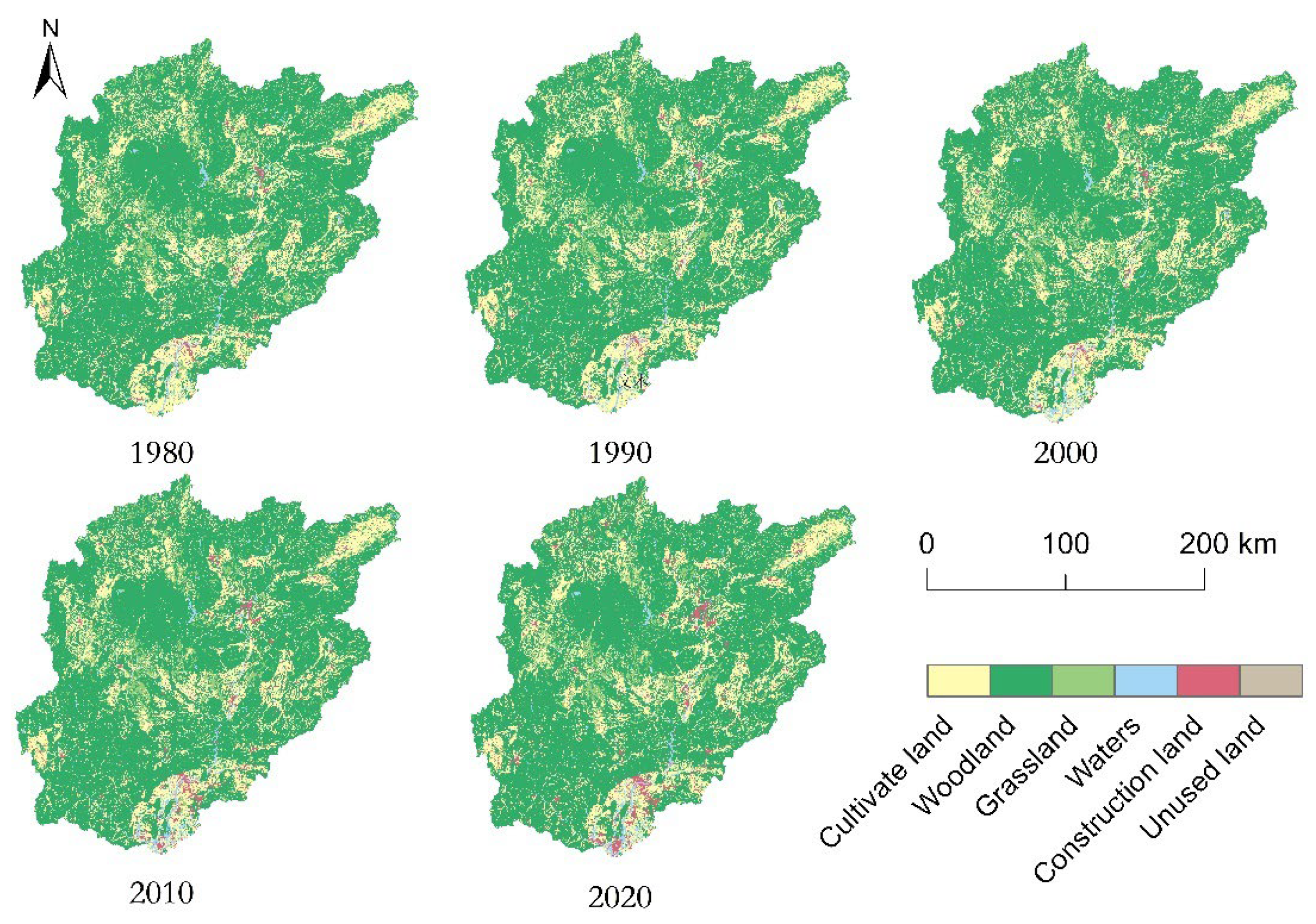
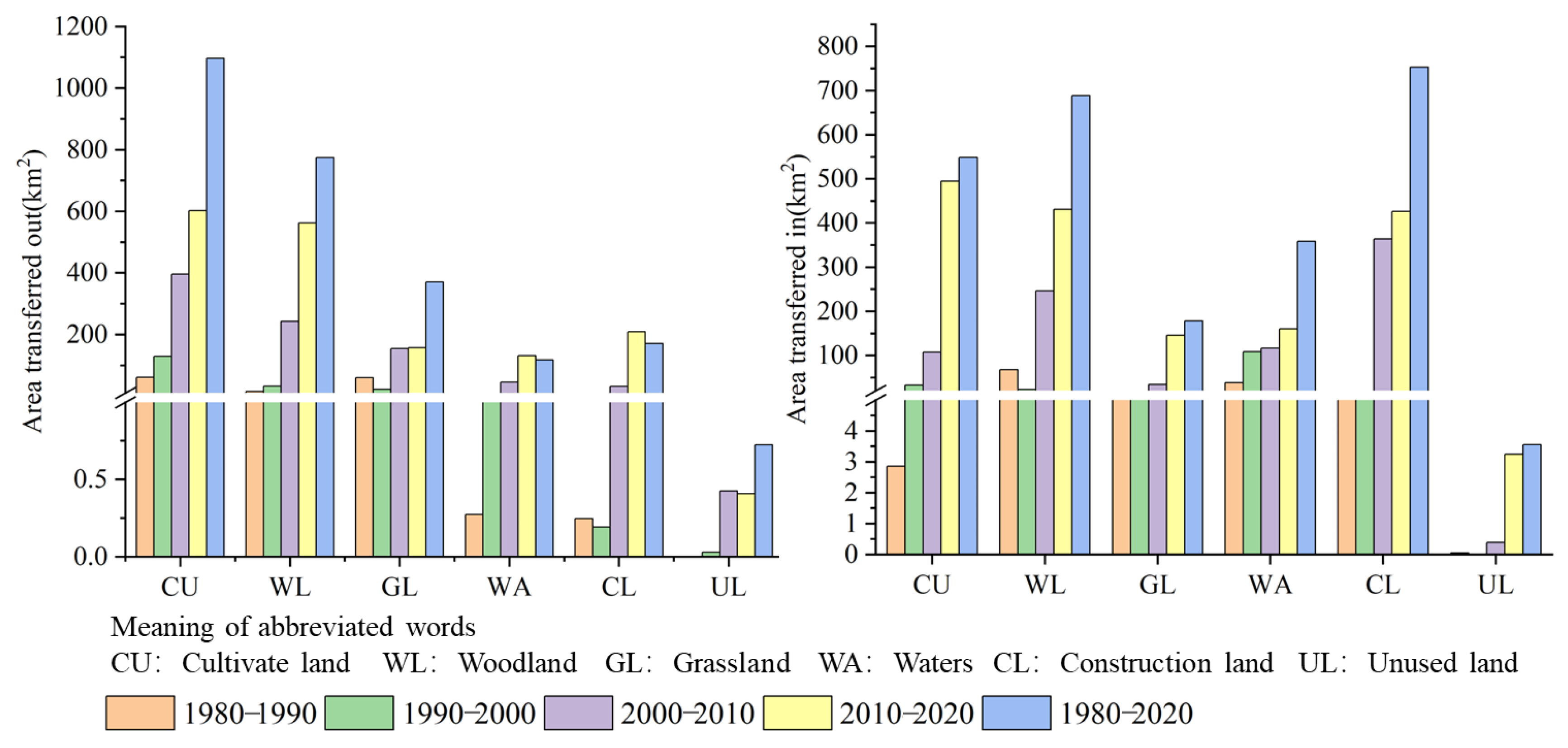
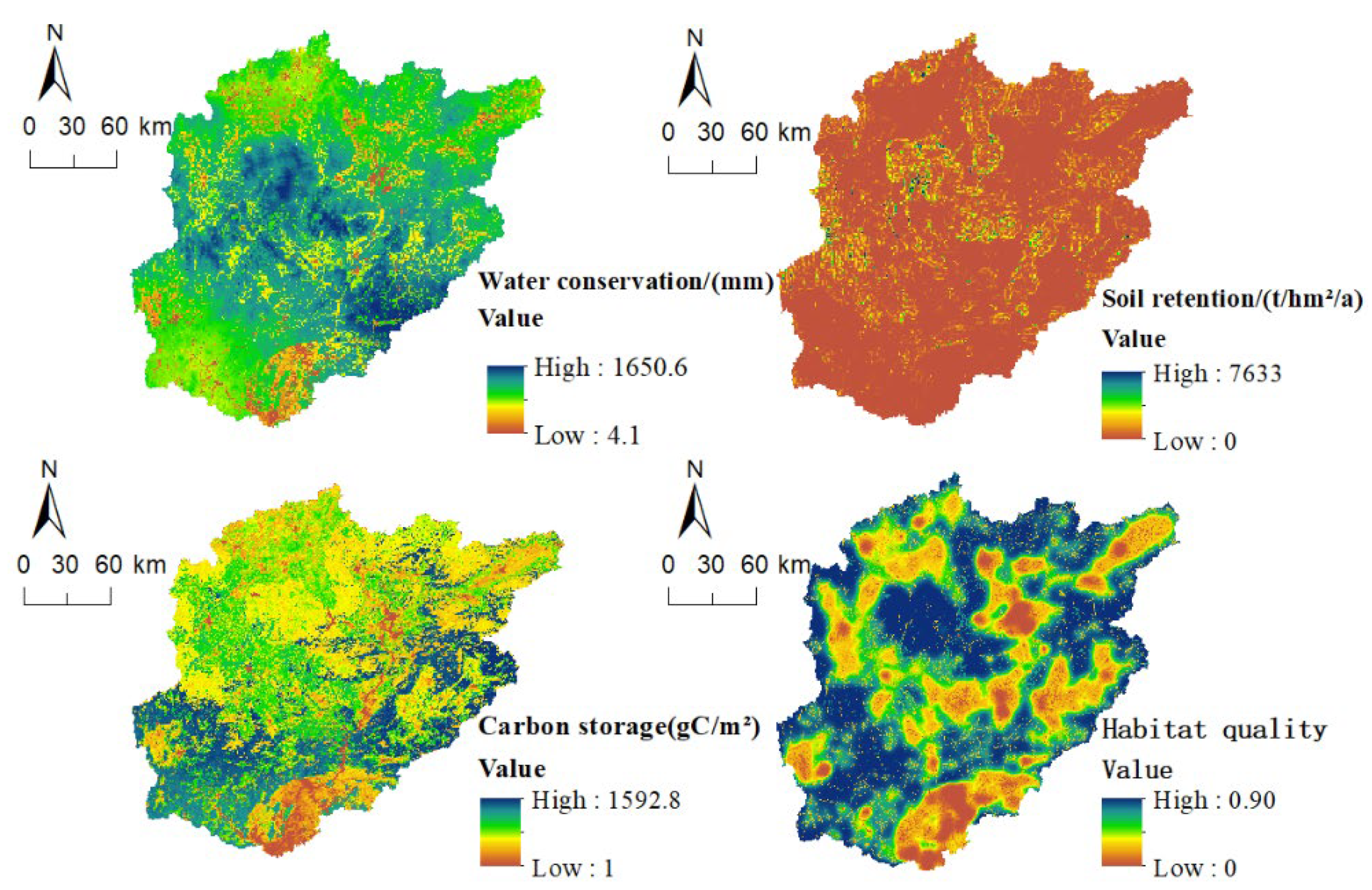

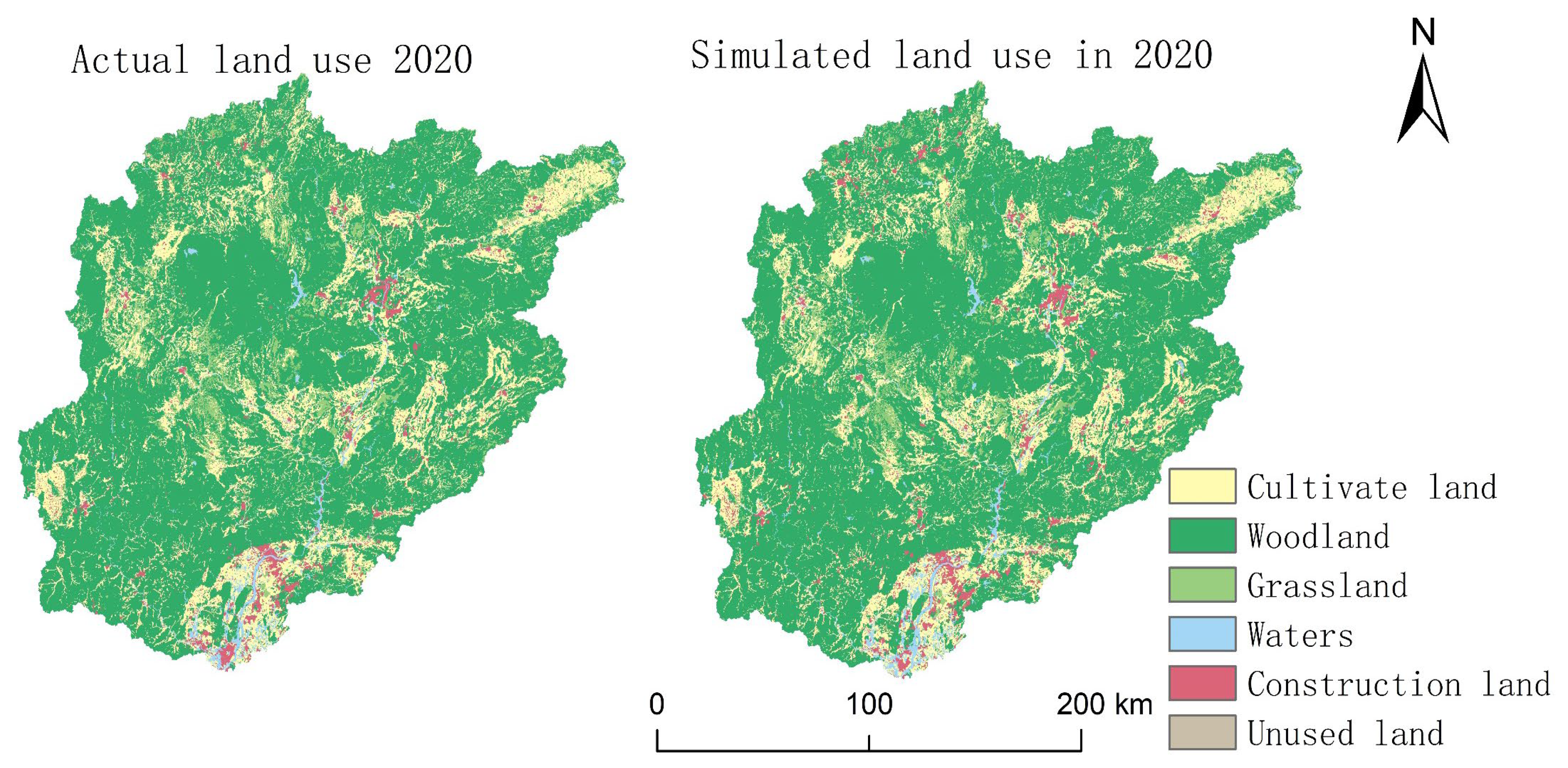
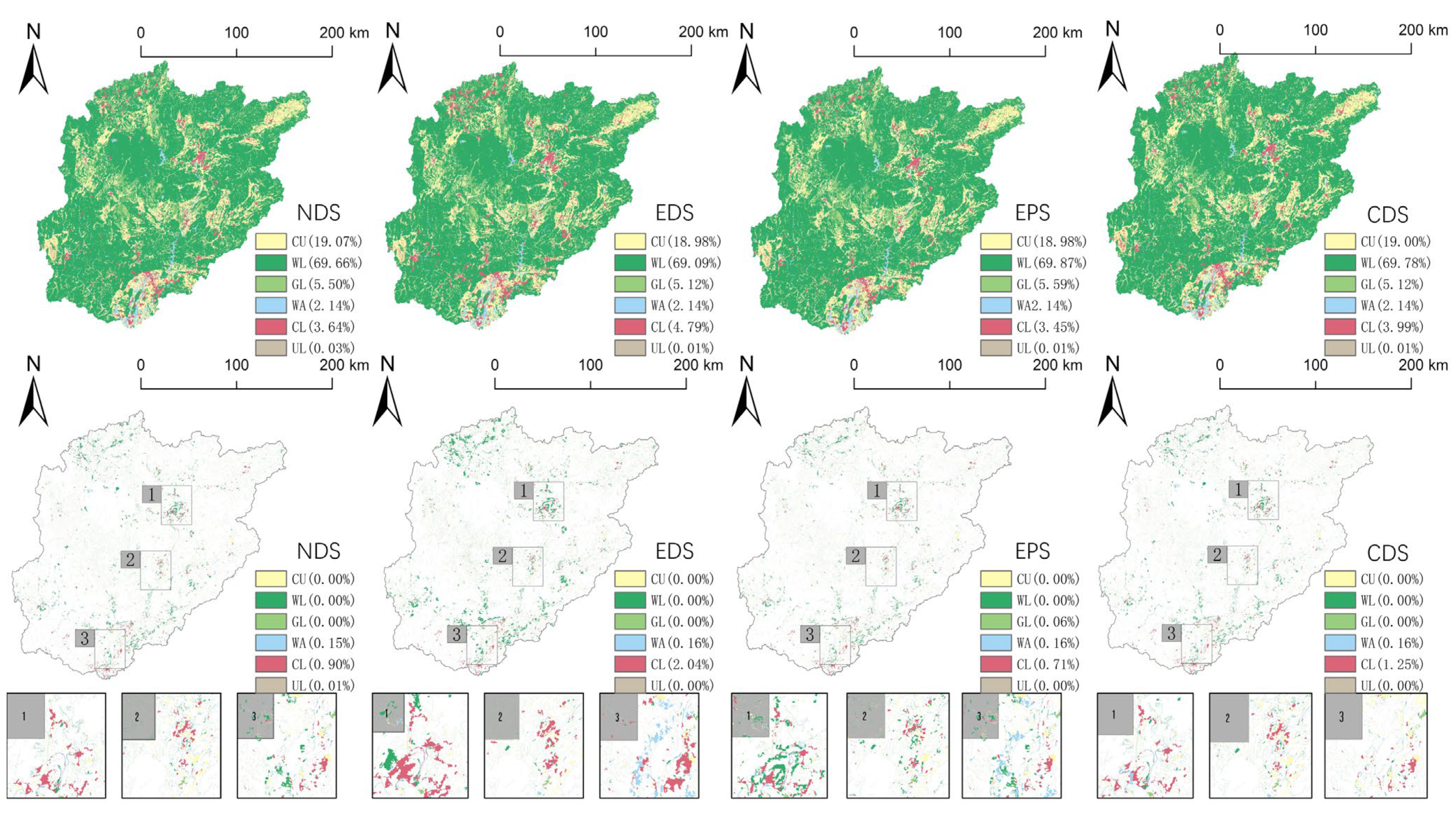
| Data Type and Purpose | Data Name | Time Resolution | Spatial Resolution | Unit | Data Sources |
|---|---|---|---|---|---|
| Natural factor (Calculation of ecosystem service functions) | DEM | / | 90 m | m | https://www.gscloud.cn/ (accessed on 10 June 2024) |
| Slope | / | 90 m | ° | ||
| Average annual temperature | 2010 | 1000 m | 0.1 °C | https://www.resdc.cn/ (accessed on 12 June 2024) | |
| Average annual precipitation | 2010 | 1000 m | 0.1 mm | ||
| Soil type | 1995 | 1000 m | / | ||
| Distance to water | 2021 | 100 m | m | https://www.openstreetmap.org (accessed on 10 June 2024) | |
| Socio-economic factors (Driving factors of land use simulation) | Population density | 2010 | 1000 m | / | https://www.resdc.cn/ (accessed on 12 June 2024) |
| Average GDP | 2010 | 1000 m | / | ||
| Distance to railway | 2021 | 100 m | m | https://www.openstreetmap.org (accessed on 20 June 2024) | |
| Distance to motorway | |||||
| Distance to main road | |||||
| Distance to primary road | |||||
| Distance to secondary roads | |||||
| Distance to tertiary road | |||||
| Distance to urban area | |||||
| Distance to township | |||||
| Distance to railway station | |||||
| Distance to bus station | |||||
| Distance to hospital | |||||
| Distance to school |
| Threat Factor | Maximum Impact Distance/m | Weights % |
|---|---|---|
| Townland | 10,000 | 100 |
| Rural land | 8000 | 80 |
| Other construction land | 9000 | 90 |
| Farmland | 6000 | 60 |
| Unused land | 4000 | 40 |
| Land Use/Cover | Habitat Suitability | Townland | Townland | Townland | Townland | Townland |
|---|---|---|---|---|---|---|
| Cultivated land | 30 | 80 | 60 | 70 | 0 | 40 |
| Forest land | 100 | 80 | 70 | 70 | 60 | 20 |
| Grassland | 100 | 70 | 50 | 60 | 50 | 60 |
| Water | 90 | 70 | 60 | 70 | 40 | 40 |
| Construction land | 0 | 0 | 0 | 0 | 0 | 0 |
| Unused land | 60 | 60 | 50 | 60 | 40 | 0 |
| Factor | Cultivated Land | Forest Land | Grassland | Water | Construction Land | Unused Land |
|---|---|---|---|---|---|---|
| Land cover type | <50 m | 50~200 m | 200~500 m | 500~1000 m | >1000 m | 0.14 |
| Dem | <2° | 2~5° | 5~15° | 15~25° | >25° | 0.16 |
| Slope | <1000 m | 1000~3000 m | 3000~5000 m | 5000~10,000 m | >10,000 m | 0.15 |
| Distance to river | 0.8~1.0 | 0.6~0.8 | 0.4~0.6 | 0.2~0.4 | 0~0.2 | 0.22 |
| NDVI | >2000 m | 1000~2000 m | 500~1000 m | 250~500 m | <250 m | 0.11 |
| Distance to road | <50 m | 50~200 m | 200~500 m | 500~1000 m | >1000 m | 0.14 |
| Land Use Type | Cultivated Land | Woodland | Grassland | Water | Construction Land | Unused Land | |
|---|---|---|---|---|---|---|---|
| 1980 | Area/km2 | 9688.643 | 33,288.630 | 2802.056 | 693.718 | 710.690 | 2.148 |
| ratio/% | 20.533 | 70.548 | 5.938 | 1.470 | 1.506 | 0.005 | |
| 1990 | Area/km2 | 9631.102 | 33,341.542 | 2754.072 | 731.566 | 725.309 | 2.198 |
| ratio/% | 20.411 | 70.660 | 5.837 | 1.550 | 1.537 | 0.005 | |
| 2000 | Area/km2 | 9534.738 | 33,331.501 | 2741.279 | 834.026 | 742.086 | 2.171 |
| ratio/% | 20.207 | 70.639 | 5.810 | 1.768 | 1.573 | 0.005 | |
| 2010 | Area/km2 | 9247.496 | 33,334.790 | 2621.437 | 905.587 | 1074.606 | 2.133 |
| ratio/% | 19.598 | 70.646 | 5.556 | 1.919 | 2.277 | 0.005 | |
| 2020 | Area/km2 | 9140.666 | 33,202.331 | 2610.089 | 934.634 | 1292.594 | 4.965 |
| ratio/% | 19.372 | 70.365 | 5.532 | 1.981 | 2.739 | 0.011 |
| Land Use Type | 1980–1990 | 1990–2000 | 2000–2010 | 2010–2020 | 1980–2020 | |
|---|---|---|---|---|---|---|
| Single dynamic degrees | Cultivated land | −0.06 | −0.10 | −0.31 | −0.12 | −0.60 |
| Forest land | 0.02 | 0.00 | 0.00 | −0.04 | −0.03 | |
| Grassland | −0.17 | −0.05 | −0.46 | −0.04 | −0.74 | |
| Water | 0.52 | 1.23 | 0.79 | 0.31 | 2.58 | |
| Construction land | 0.20 | 0.23 | 3.09 | 1.69 | 4.50 | |
| Unused land | 0.23 | −0.12 | −0.18 | 5.70 | 5.67 | |
| Comprehensive dynamic degrees | 0.02 | 0.03 | 0.09 | 0.05 | 0.18 |
| 2020 | ||||||||
|---|---|---|---|---|---|---|---|---|
| 1980 | Cultivated Land | Woodland | Grassland | Water | Construction Land | Unused Land | Total | Transition-out Area |
| Cultivated land | 8591.86 | 374.74 | 39.04 | 248.05 | 434.10 | 0.44 | 9688.24 | 1096.38 |
| Forest land | 320.72 | 32,508.83 | 125.42 | 85.57 | 240.44 | 1.65 | 33,282.62 | 773.79 |
| Grassland | 47.00 | 261.91 | 2430.92 | 10.57 | 50.32 | 0.34 | 2801.05 | 370.13 |
| Water | 57.57 | 27.19 | 4.55 | 576.68 | 27.61 | 0.09 | 693.70 | 117.02 |
| Construction land | 122.96 | 24.02 | 9.47 | 13.54 | 539.64 | 1.02 | 710.66 | 171.01 |
| Unused land | 0.15 | 0.12 | 0.02 | 0.14 | 0.30 | 1.42 | 2.14 | 0.72 |
| Total | 9140.25 | 33,196.81 | 2609.41 | 934.55 | 1292.42 | 4.97 | 47,178.41 | 2529.06 |
| Transition-in area | 548.39 | 687.98 | 178.50 | 357.87 | 752.78 | 3.55 | 2529.06 | |
| ES Type | Ecological Source Area (km2) | Ecological Corridor Area (km2) | Total ES Area (km2) | Percentage |
|---|---|---|---|---|
| BES | 11,224.63 | 983.15 | 12,207.78 | 25.86 |
| SES | 12,655.81 | 1910.94 | 14,566.75 | 30.86 |
| IES | 14,457.51 | 3088.29 | 17,545.8 | 37.17 |
| Cultivated Land | Forest Land | Grassland | Water | Construction Land | Unused Land | |
|---|---|---|---|---|---|---|
| NDS (km2) | 9140.67 | 33,202.33 | 2610.09 | 934.63 | 1292.59 | 4.97 |
| EDS (km2) | 9002.95 | 32,868.41 | 2594.25 | 1009.94 | 1722.74 | 7.84 |
| EPS (km2) | 8912.95 | 32,602.66 | 2414.25 | 1009.94 | 2258.74 | 7.58 |
| CDS (km2) | 8957.95 | 32,966.59 | 2639.25 | 1009.94 | 1628.74 | 3.66 |
| NDS (%) | −1.51 | −1.01 | −0.61 | 8.06 | 32.97 | 57.83 |
| EDS (%) | −2.49 | −1.81 | −7.5 | 8.06 | 74.75 | 52.73 |
| CDS (%) | −2.00 | −0.71 | 1.12 | 8.06 | 26.01 | −26.37 |
| NDS (%) | −1.90 | −1.07 | −4.46 | 8.06 | 45.50 | 36.00 |
Disclaimer/Publisher’s Note: The statements, opinions and data contained in all publications are solely those of the individual author(s) and contributor(s) and not of MDPI and/or the editor(s). MDPI and/or the editor(s) disclaim responsibility for any injury to people or property resulting from any ideas, methods, instructions or products referred to in the content. |
© 2024 by the authors. Licensee MDPI, Basel, Switzerland. This article is an open access article distributed under the terms and conditions of the Creative Commons Attribution (CC BY) license (https://creativecommons.org/licenses/by/4.0/).
Share and Cite
Wang, Y.; Wang, J.; Hao, B.; Zhang, S.; Ding, J.; He, B. Multi-Scenario Simulation of Future Land Use in the Beijiang River Basin Under Multidimensional Ecological Constraints. Sustainability 2024, 16, 10910. https://doi.org/10.3390/su162410910
Wang Y, Wang J, Hao B, Zhang S, Ding J, He B. Multi-Scenario Simulation of Future Land Use in the Beijiang River Basin Under Multidimensional Ecological Constraints. Sustainability. 2024; 16(24):10910. https://doi.org/10.3390/su162410910
Chicago/Turabian StyleWang, Yi, Jun Wang, Beibei Hao, Siyi Zhang, Junwei Ding, and Bin He. 2024. "Multi-Scenario Simulation of Future Land Use in the Beijiang River Basin Under Multidimensional Ecological Constraints" Sustainability 16, no. 24: 10910. https://doi.org/10.3390/su162410910
APA StyleWang, Y., Wang, J., Hao, B., Zhang, S., Ding, J., & He, B. (2024). Multi-Scenario Simulation of Future Land Use in the Beijiang River Basin Under Multidimensional Ecological Constraints. Sustainability, 16(24), 10910. https://doi.org/10.3390/su162410910







